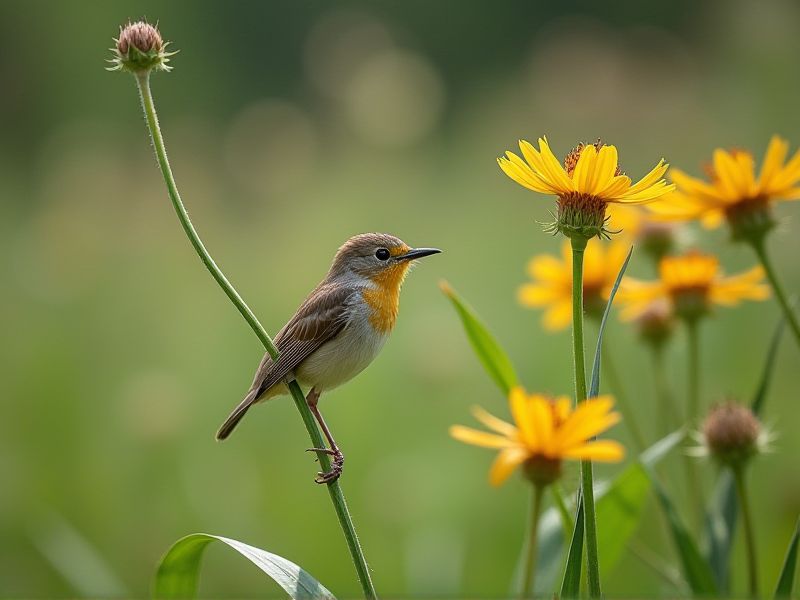
Wetland plants such as cattails, bulrushes, and marsh marigolds create an ideal habitat for a variety of bird species, including herons, ducks, and songbirds. These plants provide essential food sources, such as seeds and insects, while also offering shelter and nesting spots. The dense growth of wetland vegetation helps in concealing nests from predators, increasing the chances of successful breeding. Integrating native wetland plants in your landscape can enhance biodiversity and make your area a haven for avian wildlife. By supporting local ecosystems, you contribute to the preservation of essential habitats that sustain bird populations.
List of some Wetland plants that attract birds
- Common Cattail (Typha latifolia)
- Swamp Milkweed (Asclepias incarnata)
- Cardinal Flower (Lobelia cardinalis)
- Blue Flag Iris (Iris versicolor)
- Marsh Marigold (Caltha palustris)
- Buttonbush (Cephalanthus occidentalis)
- Pickerelweed (Pontederia cordata)
- Arrowhead (Sagittaria latifolia)
- Great Blue Lobelia (Lobelia siphilitica)
- Soft Rush (Juncus effusus)
Important things about Wetland plants that attract birds
Native Plant Species
Wetland plants such as cattails, bulrushes, and saltmarsh cordgrass serve as essential habitats for birds, offering both shelter and food sources. These native species create a rich ecosystem by providing seeds and insects that attract various bird species, including ducks, herons, and songbirds. The dense foliage of wetland plants also offers nesting sites, ensuring safe breeding grounds. By incorporating these native plants into your landscape, you can enhance local biodiversity and create a vibrant environment that supports diverse avian populations.
Dense Foliage
Wetland plants such as cattails, bulrushes, and various species of sedges create dense foliage that serves as crucial habitat for many bird species. These plants provide shelter and nesting sites, while their seeds serve as a food source that attracts birds like ducks, shorebirds, and songbirds. The intricate root systems also filter water and improve water quality, contributing to a healthier ecosystem that supports diverse avian populations. By incorporating native wetland plants in your landscape, you can create an inviting environment that fosters birdwatching opportunities and ecological balance.
Seed Production
Wetland plants such as bulrush, cattail, and pickerelweed are essential for seed production, providing a rich food source for various bird species. These plants produce abundant seeds that not only nourish birds but also contribute to the overall health of wetland ecosystems. Creating habitat by planting native wetland species can enhance birdwatching opportunities in your area. By maintaining a diverse wetland environment, you support sustained bird populations that rely on these vital seed sources for their survival.
Fruit-Bearing Plants
Wetland plants such as various species of *Ilex* (holly) and *Sambucus* (elderberry) are popular for attracting birds due to their abundant fruit production. These native plants thrive in saturated soils, providing vital habitat and nourishment for avian species. The berries produced by these plants not only offer food for migratory and resident birds but also serve as an essential energy source during breeding seasons. Incorporating these fruit-bearing wetland plants in your garden can enhance biodiversity while creating a vibrant ecosystem for birdwatching.
Water-Loving Plants
Wetland plants such as cattails, bulrushes, and water lilies provide essential habitats for various bird species. By incorporating these native flora into your landscape, you can create an inviting environment that attracts waterfowl, songbirds, and shorebirds. The dense foliage offers shelter for nesting birds, while the abundant seeds and insects serve as a vital food source. Managing these wetland areas responsibly not only supports local biodiversity but also enhances your enjoyment of wildlife watching.
Nesting Sites
Wetland plants such as bulrushes, cattails, and water lilies create ideal nesting sites for various bird species, including herons and swans. These plants provide essential cover and protection from predators while offering abundant food sources, such as insects and seeds. The dense root systems help stabilize shorelines, maintaining the overall health of the wetland ecosystem. By incorporating native wetland vegetation in your landscaping, you can enhance local biodiversity and support avian populations in your area.
Shelter From Predators
Wetland plants such as cattails, bulrushes, and sedges provide essential shelter from predators for various bird species. These dense, tall vegetation types create a safe haven where birds can nest, feed, and escape from threats. The seeds and insects that thrive within these plants also attract birds, making wetland areas vibrant ecosystems. By incorporating native wetland plants in your garden or conservation area, you can help support local bird populations and promote biodiversity.
Pollen And Nectar Sources
Wetland plants serve as vital pollen and nectar sources, attracting a variety of bird species essential for ecosystem balance. Native flowering plants like blue flag iris and pickerel weed provide abundant nectar that supports hummingbirds and butterflies, while also attracting insects that serve as food for bird populations. The dense foliage and structure of these plants offer nesting sites and shelter, further enhancing the habitat's appeal to birds. By nurturing and preserving wetland ecosystems, you contribute to the survival of these avian species and the overall biodiversity of your region.
Seasonal Flowering
Wetland plants such as cattails, bulrushes, and swamp milkweed play a crucial role in supporting seasonal flowering, which provides essential resources for birds. These vibrant blooms offer critical nectar and seeds, attracting various avian species during migration and breeding seasons. By cultivating these native wetland plants in your garden or restoration projects, you can create a thriving habitat that enhances biodiversity. Furthermore, healthy wetland ecosystems not only improve water quality but also provide nesting sites and shelter for birds, promoting their population stability.
Biodiversity Promotion
Wetland plants play a crucial role in promoting biodiversity, particularly in attracting various bird species. Species such as cattails, bulrushes, and pickerel weed provide essential habitats and food sources, fostering rich ecosystems. By incorporating native wetland plants in your landscape, you can create inviting environments for birds that thrive in these unique habitats, like herons and waterfowl. Protecting these vital areas through conservation and restoration efforts ensures the continued flourishing of both plant and bird populations.
